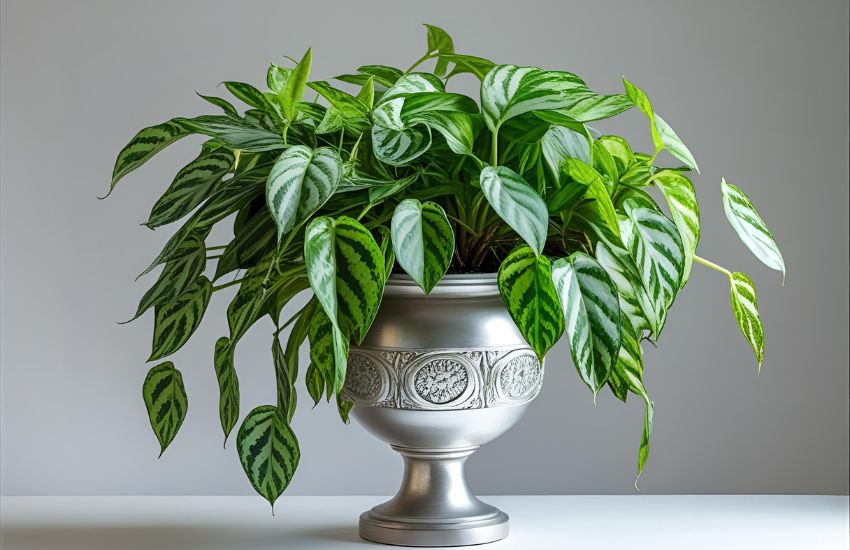Looking for a striking houseplant that adds both elegance and ease to your indoor space? The Aechmea Fasciata, also known as the silver vase plant, is a stunning choice with its silvery-green foliage and striking pink bracts that surround a central inflorescence. As an epiphyte from the Bromeliaceae family, this plant thrives in well-drained conditions and adapts beautifully to life indoors. The rosette-shaped leaves not only give it a showy, sculptural appearance but also help the plant grow healthily in low-maintenance settings.
The Aechmea Fasciata Plant, also known as the Silver Vase Plant, is a stunning houseplant with broad silver-green leaves and a striking pink flower. This low-maintenance beauty thrives in indirect light and finely shredded pine bark. Keep water at all times in its central urn and occasionally add fertilizer to the water for vibrant growth.
In this blog, you’ll discover how to keep your urn plant vibrant, help your plant bloom, and encourage your urn plant to bloom again with the right techniques. Let’s guide you step by step through care, flowering, and replanting success.
Why the Aechmea fasciata plant Is a Perfect Long-Lasting Indoor Houseplant

The Aechmea fasciata, commonly known as the urn plant or silver vase plant, is celebrated among indoor gardening enthusiasts for its elegant structure, vibrant display, and minimal maintenance needs. This known species from the bromeliad family is not only a decorative feature but also a practical choice for your home. Here’s why it’s the perfect long-lasting houseplant for your indoor collection.
Striking Appearance and Structural Elegance
With its bold, arching leaves with silver bands and a sculptural basal rosette, the mature plant offers a modern yet tropical flair. When in bloom, the central cup holds a showy pink bract that emerges proudly, followed by small purple or purple flowers. These blooms are not only beautiful but also persist for months, making it a rewarding centerpiece for your space.
Adaptable to Indoor Environments
Native to Brazil, this epiphytic plant thrives in partial shade and should be kept out of direct sun to avoid leaf burn. Aechmea fasciata requires a moist but well-drained potting mix and prefers humidity, which can be increased by placing it on a tray of moss or pebbles. The central cup should be filled with water to mimic its natural habitat, and gentle feeding with a diluted fertilizer during the growing season supports a healthy bloom.
Easy Care and Propagation
Urn plant care is straightforward. To prevent crown rot, avoid overwatering the base of the plant or letting stagnant water accumulate for long periods. After flowering, the mother plant will slowly decline—but don’t worry—the entire plant doesn’t go to waste. It produces offsets near the base of the plant, and these offsets can be transplanted into their own pots for continued enjoyment. Use a clear plastic bag over young pups to retain moisture during propagation.
Reliable Blooming Cycle
Encouraging your urn plant to bloom again may take time, but it’s possible with the right techniques. Placing the plant out of direct sun, maintaining adequate humidity, and occasionally using a ripening apple near the plant inside a plastic bag can stimulate flowering hormones naturally.
Tips to Get Your Aechmea fasciata plant to Bloom Beautifully in Any Pot

To help your Aechmea fasciata plant bloom beautifully in any pot, follow these essential care tips:
- Provide bright, indirect light: Avoid direct sun, which can scorch the strap-shaped leaves. Place the plant near a well-lit window to mimic its natural tropical environment.
- Use a well-draining potting mix: A mix containing perlite improves drainage and prevents waterlogging. This is vital for maintaining root health and encouraging flowering.
- Keep water in the central cup: Regularly refresh the water in the central cup to keep the plant hydrated. This mimics how it collects rainwater in the wild.
- Encourage blooming naturally: Place the plant inside a clear plastic bag with a ripe apple for 3–5 days. The ethylene gas released will help stimulate flower production.
- Expect vibrant flowers: When the plant is ready, it will produce showy pink bracts followed by small purple flowers, lasting for several months.
- Be patient—blooming takes time: This plant is native to southeastern Brazil and has a slow bloom cycle. After flowering, the plant dies, but it will leave behind pups for propagation.
- Watch for pests: Check leaf tips and crevices for scale and mealybugs, which can affect plant health and delay blooming.
- Understand its natural growth: In the wild, it may grow in the ground or in trees, forming a rosette of leaves that supports long-term growth and flower development.
Conclusion
The Aechmea fasciata, probably the best known species of the bromeliad family, stands out as a resilient and visually striking option among indoor plants. With its basal rosette of stiff leaves and stunning blooms, it offers long-lasting beauty with minimal effort. The plant’s adaptability makes it ideal for modern living spaces, especially when placed in a pot filled with a well-draining mix such as finely shredded pine bark. To maintain optimal health, remember to keep the soil lightly moist and ensure there is water at all times in the central cup.
To encourage blooming, try placing a ripe apple at the base and cover the plant with a clear plastic bag—this natural method helps trigger flowering. Regularly adding a diluted fertilizer to the water also supports growth and bloom. Be mindful of potential issues like leaf spot and crown rot, and avoid excessive moisture around the base. If you notice brown leaf tips or black edges where leaf margins have black, adjust your watering and humidity accordingly.
Whether you’re new to plant care or expanding your indoor plants collection, Aechmea fasciata is an elegant and rewarding choice. Ready to bring home this tropical beauty? Start growing your own silver vase plant today and experience the joy of watching pups form at the base and new blooms unfold naturally.
